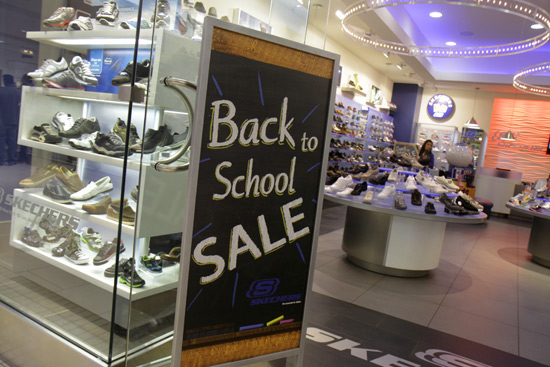促銷活動天天有,顧客買賬嗎?

|
伯格在回憶往昔短暫的開學(xué)季購物促銷時段時說:“在以前,開學(xué)季的店面購物場面就像是斗毆。”如今,“這類促銷已延長至五個星期。” 加長版開學(xué)季購物促銷也成為了其他年度促銷活動的真實寫照,而零售商們也會為了招攬顧客而延長這些促銷活動的時長。黑色星期五依然是年終促銷大餐的頭菜,但如今也出現(xiàn)了一個跟班——網(wǎng)絡(luò)星期一這個線上購物節(jié)。然而,假日銷售的大部分業(yè)績依然源自于打折活動滿天飛的12月。 即便是亞馬遜發(fā)起的仲夏促銷活動Prime Day也被延長至兩日的時間,而其前后端則充斥著其競爭對手們的加長版促銷活動。 無止盡的促銷活動 對于服飾連鎖店來說,此舉通常意味著相互之間的促銷滲透,而各大公司也是絞盡了腦汁,為的是讓消費者在本輪促銷結(jié)束之前就開始關(guān)注下一輪的打折活動。 咨詢公司Customer Growth Partners LLC總裁克雷格·約翰遜說:“如今,促銷活動實在是太多,以至于人們可能都司空見慣了,而且對此感到厭煩。” 無休止的促銷已經(jīng)改變了購物者心態(tài),如今很多消費者希望在任何時段都能享受到折扣,而不是一年中的某幾個特定時段。 李維斯的伯格說:“消費者對于所有的促銷活動已經(jīng)感到麻木不仁。因此,開學(xué)季20%的折扣與9月初即將開展的促銷活動沒有什么區(qū)別,反正屆時也會是20%的折扣。” 痛苦的庫存 這一現(xiàn)象正在迫使零售商更加靈活地管理其庫存,并保持新產(chǎn)品管線的流動,這樣,消費者在任何購物季多次返店時也會有新品可供選擇。 如果產(chǎn)品的流動速度不夠快,那么零售商可能會陷入麻煩,不斷堆積的庫存會侵蝕盈利能力,因為庫存的存儲和管理都需要費用,而且公司不得不進一步打折才能把庫存賣出去。Gap公司和 J.C. Penney Co.近些年來都遇到了積壓庫存的高成本問題,后通過減價才將其清理掉。 約翰遜說:“公司希望擺脫庫存,然后引進一些新產(chǎn)品,因為公司并不愿意產(chǎn)品上架兩個月之后還在銷售。” 庫存的正確管理會帶來很高的回報:RetailMeNot的一項調(diào)查稱,今年,美國父母預(yù)計在衣服、電子產(chǎn)品和其他與學(xué)校相關(guān)的物品上的平均花費將達到507美元,較去年的465美元有所上升。與此同時,德勤發(fā)現(xiàn),幼兒園到12年級開學(xué)季購物開支今年共計達到了278億美元,較2018年增長了1.8%。 維持顧客的興趣 為了在競爭中脫穎而出,各大連鎖店祭出了新招,例如通過將目光轉(zhuǎn)移至孩子自身來獲取靈感。 Gap旗下的特價服飾連鎖店Old Navy正在銷售印有8-12歲孩子畫作的T恤。American Eagle最近組建了一個年輕成年人“理事會”,部分原因是為了幫助給今年的產(chǎn)品選擇提供指導(dǎo)。在他們的推薦下,該連鎖店如今在店面增加了尺碼規(guī)格的供應(yīng)范圍。與此同時, J.C. Penney正在為小學(xué)和中學(xué)學(xué)生提供10美元的理發(fā)服務(wù) American Eagle Outfitters Inc.是一家以青少年和年輕成年人為主要目標(biāo)群體的公司,其全球品牌業(yè)務(wù)總裁查德·克斯勒稱,顧客每人選擇來店的次數(shù)并非只有一次,而是多次。其中一個原因在于同伴壓力。 克斯勒說:“孩子們回到學(xué)校,看到其他孩子的穿著之后,會回店選一些新款式。” 李維斯的伯格也有同感,他說:“很多孩子都會先等等,看看Instagram上有哪些熱門服飾,以及其他耍酷的孩子在回到學(xué)校后穿的是什么。他們會推遲購買,并等到真正了解自己想要什么之后才出手。” 鑒于開學(xué)季購物之后的返店購物逐漸成為常態(tài),這意味著“我們得確保每個月都有新貨推出,這樣,客戶每一次返店都能有新發(fā)現(xiàn)”,克斯勒說道。 Customer Growth Partners的約翰遜表示,零售商成功的關(guān)鍵在于要成為顧客肚子里的蛔蟲。 約翰遜說:“如果你是一家服飾零售商,你就得確保能夠緊跟時尚潮流。如果你的賭注下的太大,而且沒有人購買,那么就會因此而陷入困境。”(財富中文網(wǎng)) 譯者:馮豐 審校:夏林 |
“Back-to-school used to be a moment,” Bergh said, recalling the briefer periods of yore “where it was like a fistfight in the stores.” Today, “it’s morphed into five weeks.” The prolonged back-to-school season mirrors what’s happened with other annual sales events, as retailers drag out the moments that bring shoppers in the door. Black Friday, still the kickoff for the crucial year-end period, is now followed by the online deals of Cyber Monday—but the lion’s share of holiday sales come in discount-fueled December. Even Prime Day, the mid-summer event invented by Amazon.com Inc., has been stretched to encompass two days, with competitors extending their promotions on the front and back ends. Endless sales For apparel chains, this often means that sales bleed into each other, and companies struggle to get shoppers excited for the next round of discounting before the current one has ended. “Everything is so over-promoted these days,” said Craig Johnson, president of Customer Growth Partners LLC. “People can be promoted out. They get bored with it.” The endless sales have changed shoppers’ attitudes, with many now expecting discounts available at any given moment, rather than at designated times of the year. “Consumers are numb to all the promotional activity,” Levi’s Bergh said. “So a 20% back-to-school offer is no different than whatever is going to happen in early September, when it’s going to be 20% off anyway.” Inventory woes This is forcing retailers to manage their inventories more nimbly and keep the pipeline of new products flowing so the selection feels fresh for shoppers who visit several times during any given season. Failing to move product quick enough can be detrimental for retailers—piled up inventory erodes profitability because it costs money to store and organize it, and companies have to discount deeply to get rid of it. Both Gap Inc. and J.C. Penney Co. have gone through costly buildups of inventory in recent years that required markdowns to clear up. “You want to get rid of it and then you want some new product coming in,” Johnson said. “You don’t want to keep selling the same stuff that you’ve been selling for two months.” The stakes are high to get it right: This year, American parents are expected to spend $507 on average for clothing, electronics and other school-related items, according to a study from RetailMeNot. That’s up from $465 in 2018. Deloitte, meanwhile, sees back-to-school spending for kindergarten through 12th grade totaling $27.8 billion this year, a rise of 1.8% from 2018. Keeping customers interested To stand out amid the crowd, chains are trying new tactics—such as turning to the kids themselves for inspiration. Old Navy, the off-price apparel chain owned by Gap, is selling T-shirts featuring drawings by 8-to-12-year-olds. American Eagle recently formed a “council” of young adults that was created, in part, to help guide its product selection this year. On their recommendation, the chain now stocks a larger range of sizes in its stores. J.C. Penney, meanwhile, is offering $10 haircuts for elementary and middle school students. American Eagle Outfitters Inc., which caters to mostly teenagers and young adults, is seeing shoppers opt for multiple trips to the store per season instead of just one, according to Chad Kessler, the company’s global brand president. Part of it is driven by peer pressure. “Kids go back to school, see what the other kids are wearing and come back for something new,” Kessler said. Levi’s Bergh echoed that sentiment. “A lot of the kids want to wait until they see what’s hot on Instagram and what the cool kids are wearing when they go back to school,” he said. “They can defer that purchase and wait until they really know what they really want.” With repeat back-to-school shopping visits becoming the norm, that means “making sure that we have delivery every month, so every time the customer comes back, they have something new,” Kessler said. Johnson, of Customer Growth Partners, said the key to success is for retailers to have a detailed understanding of their customers. “If you’re an apparel retailer, you want to make sure you’re in tune with the styles,” Johnson said. “If you place too big a bet and nobody’s buying it, then you can get hurt.” |













